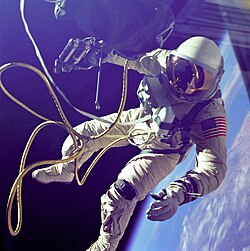
Back رحلة فضاء بشرية Arabic Pilotlu kosmik uçuş proqramı Azerbaijani Пилотиран космически полет Bulgarian মানব মহাকাশ যাত্রা Bengali/Bangla Svemirski letovi čovjeka BS Vol espacial tripulat Catalan گەشتی ئاسمانی مرۆڤ CKB Bemandet rummission Danish Bemannte Raumfahrt German Kosmoŝipo Esperanto
| Part of a series on |
| Spaceflight |
|---|
 |
|
|
Human spaceflight (also referred to as manned spaceflight or crewed spaceflight) is spaceflight with a crew or passengers aboard a spacecraft, often with the spacecraft being operated directly by the onboard human crew. Spacecraft can also be remotely operated from ground stations on Earth, or autonomously, without any direct human involvement. People trained for spaceflight are called astronauts (American or other), cosmonauts (Russian), or taikonauts (Chinese); and non-professionals are referred to as spaceflight participants or spacefarers.[1]
The first human in space was Soviet cosmonaut Yuri Gagarin, who launched as part of the Soviet Union's Vostok program on 12 April 1961 at the beginning of the Space Race. On 5 May 1961, Alan Shepard became the first American in space, as part of Project Mercury. Humans traveled to the Moon nine times between 1968 and 1972 as part of the United States' Apollo program, and have had a continuous presence in space for 24 years and 242 days on the International Space Station (ISS).[2] On 15 October 2003, the first Chinese taikonaut, Yang Liwei, went to space as part of Shenzhou 5, the first Chinese human spaceflight. As of March 2025, humans have not traveled beyond low Earth orbit since the Apollo 17 lunar mission in December 1972.
Currently, the United States, Russia, and China are the only countries with public or commercial human spaceflight-capable programs. Non-governmental spaceflight companies have been working to develop human space programs of their own, e.g. for space tourism or commercial in-space research. The first private human spaceflight launch was a suborbital flight on SpaceShipOne on June 21, 2004. The first commercial orbital crew launch was by SpaceX in May 2020, transporting NASA astronauts to the ISS under United States government contract.[3]
- ^ Mars, Kelli (27 March 2018). "5 Hazards of Human Spaceflight". NASA. Archived from the original on 28 April 2022. Retrieved 9 February 2022.
- ^ "Counting the Many Ways the International Space Station Benefits Humanity". 5 April 2019. Retrieved 4 May 2019.
- ^ "SpaceX Astronauts Reach Space Station After Milestone Voyage". Bloomberg.com. 30 May 2020. Retrieved 16 June 2020.




